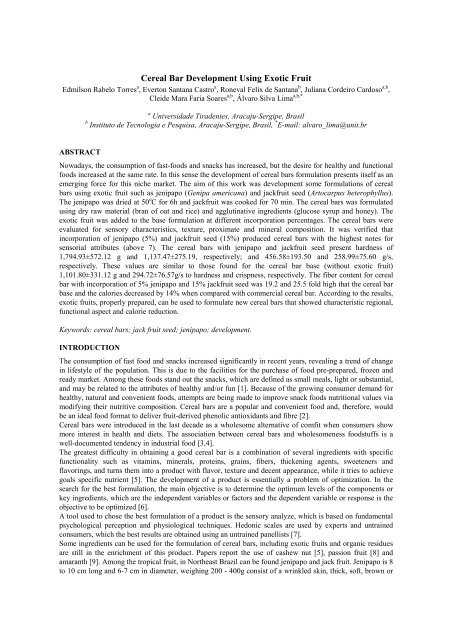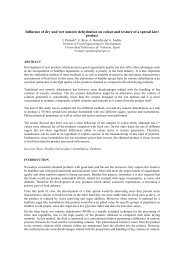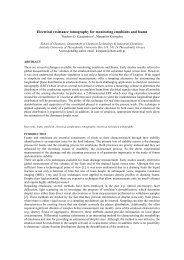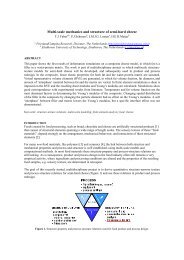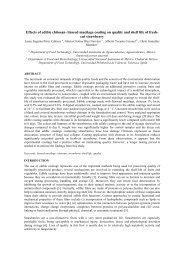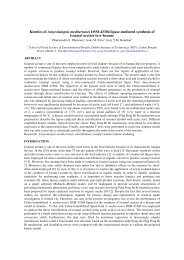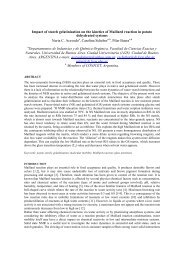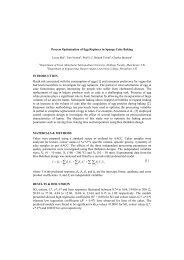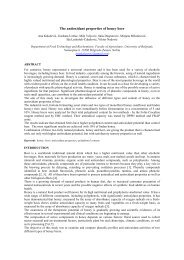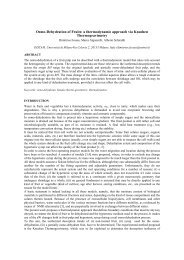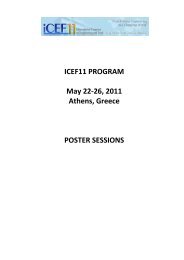Cereal Bar Development Using Exotic Fruit - 6 pages
Cereal Bar Development Using Exotic Fruit - 6 pages
Cereal Bar Development Using Exotic Fruit - 6 pages
Create successful ePaper yourself
Turn your PDF publications into a flip-book with our unique Google optimized e-Paper software.
<strong>Cereal</strong> <strong>Bar</strong> <strong>Development</strong> <strong>Using</strong> <strong>Exotic</strong> <strong>Fruit</strong><br />
Edmilson Rabelo Torres a , Everton Santana Castro a , Roneval Felix de Santana b , Juliana Cordeiro Cardoso a,b ,<br />
Cleide Mara Faria Soares a,b , Álvaro Silva Lima a,b,*<br />
ABSTRACT<br />
a Universidade Tiradentes, Aracaju-Sergipe, Brasil<br />
b Instituto de Tecnologia e Pesquisa, Aracaju-Sergipe, Brasil, * E-mail: alvaro_lima@unit.br<br />
Nowadays, the consumption of fast-foods and snacks has increased, but the desire for healthy and functional<br />
foods increased at the same rate. In this sense the development of cereal bars formulation presents itself as an<br />
emerging force for this niche market. The aim of this work was development some formulations of cereal<br />
bars using exotic fruit such as jenipapo (Genipa americana) and jackfruit seed (Artocarpus heterophyllus).<br />
The jenipapo was dried at 50 o C for 6h and jackfruit was cooked for 70 min. The cereal bars was formulated<br />
using dry raw material (bran of oat and rice) and agglutinative ingredients (glucose syrup and honey). The<br />
exotic fruit was added to the base formulation at different incorporation percentages. The cereal bars were<br />
evaluated for sensory characteristics, texture, proximate and mineral composition. It was verified that<br />
incorporation of jenipapo (5%) and jackfruit seed (15%) produced cereal bars with the highest notes for<br />
sensorial attributes (above 7). The cereal bars with jenipapo and jackfruit seed present hardness of<br />
1,794.93±572.12 g and 1,137.47±275.19, respectively; and 456.58±193.50 and 258.99±75.60 g/s,<br />
respectively. These values are similar to those found for the cereal bar base (without exotic fruit)<br />
1,101.80±331.12 g and 294.72±76.57g/s to hardness and crispness, respectively. The fiber content for cereal<br />
bar with incorporation of 5% jenipapo and 15% jackfruit seed was 19.2 and 25.5 fold high that the cereal bar<br />
base and the calories decreased by 14% when compared with commercial cereal bar. According to the results,<br />
exotic fruits, properly prepared, can be used to formulate new cereal bars that showed characteristic regional,<br />
functional aspect and calorie reduction.<br />
Keywords: cereal bars; jack fruit seed; jenipapo; development.<br />
ITRODUCTIO<br />
The consumption of fast food and snacks increased significantly in recent years, revealing a trend of change<br />
in lifestyle of the population. This is due to the facilities for the purchase of food pre-prepared, frozen and<br />
ready market. Among these foods stand out the snacks, which are defined as small meals, light or substantial,<br />
and may be related to the attributes of healthy and/or fun [1]. Because of the growing consumer demand for<br />
healthy, natural and convenient foods, attempts are being made to improve snack foods nutritional values via<br />
modifying their nutritive composition. <strong>Cereal</strong> bars are a popular and convenient food and, therefore, would<br />
be an ideal food format to deliver fruit-derived phenolic antioxidants and fibre [2].<br />
<strong>Cereal</strong> bars were introduced in the last decade as a wholesome alternative of comfit when consumers show<br />
more interest in health and diets. The association between cereal bars and wholesomeness foodstuffs is a<br />
well-documented tendency in industrial food [3,4].<br />
The greatest difficulty in obtaining a good cereal bar is a combination of several ingredients with specific<br />
functionality such as vitamins, minerals, proteins, grains, fibers, thickening agents, sweeteners and<br />
flavorings, and turns them into a product with flavor, texture and decent appearance, while it tries to achieve<br />
goals specific nutrient [5]. The development of a product is essentially a problem of optimization. In the<br />
search for the best formulation, the main objective is to determine the optimum levels of the components or<br />
key ingredients, which are the independent variables or factors and the dependent variable or response is the<br />
objective to be optimized [6].<br />
A tool used to chose the best formulation of a product is the sensory analyze, which is based on fundamental<br />
psychological perception and physiological techniques. Hedonic scales are used by experts and untrained<br />
consumers, which the best results are obtained using an untrained panellists [7].<br />
Some ingredients can be used for the formulation of cereal bars, including exotic fruits and organic residues<br />
are still in the enrichment of this product. Papers report the use of cashew nut [5], passion fruit [8] and<br />
amaranth [9]. Among the tropical fruit, in Northeast Brazil can be found jenipapo and jack fruit. Jenipapo is 8<br />
to 10 cm long and 6-7 cm in diameter, weighing 200 - 400g consist of a wrinkled skin, thick, soft, brown or
ownish - yellow, representing 9.56% of total fruit pulp and 73.81%, with very characteristic odor strong,<br />
sweet taste, acidic, involving numerous flat seeds (16.63%) [10]. The jack fruit is the largest tree-borne in the<br />
world, contend 8-15% of the fruit weight is seed. The seeds are 1.90 to 3.81 cm long and 1.27 to 1.90 cm<br />
thick and are rich in carbohydrate and fiber [11].<br />
The goal of this research is obtained cereal bars using exotic fruit (jenipapo and jack fruit seeds) in different<br />
composition and compare sensorial and physic-chemically the cereal bars developed with standard and<br />
commercial formulations.<br />
MATERIALS & METHODS<br />
Materials: The jenipapo pulp, jackfruit seed and all the raw materials to produce the cereal bars was<br />
purchased of local market from Aracaju-Sergipe, Brazil. The fruit and seed were sanitized with sodium<br />
hypochlorite, washed and drained. The jenipapo was dried at 50 o C for 6h and jackfruit was cooked for 70<br />
min. The chemicals were acquired from Labsynth (Brazil) and had analytical grade.<br />
<strong>Cereal</strong> bar formulation: The cereal bars was formulated using dry raw material (bran of oat -35% and rice –<br />
15%) and agglutinative ingredients (glucose syrup – 25% and honey – 25). The exotic fruit was added to the<br />
base formulation at different incorporation percentages. The agglutinative ingredients were heated to 95 o C<br />
and added to the dry ingredients, and then the bars were molded (9x3x1, 5cm) and cooled to -20 o C for 10<br />
min, packaged in aluminum and stored in a cool dry place at 25 o C.<br />
Centesimal composition: The cereal bars were evaluated for their physical-chemistry characteristics, in<br />
triplicate (n=3). The crude protein as N x 6.25 was determined by the Kjedahl method total lipids was<br />
analyzed by the Soxhlet method, ash was evaluated by burning the sample at 550 o C, total dietary fiber was<br />
determined of Wood method, moisture was analyzed in an oven at 105 o C until constant weight [12]. The<br />
water activity (aw) was measured using a hygrometer (Aqualab, Decagon 3TE). Carbohydrate were calculated<br />
by the difference method (100-water-protein-lipid-ash-fiber) and energy values (cal) were evaluated applying<br />
the factor 4, 9 and 4 for each gram of protein, lipid and carbohydrate, respectively [13].<br />
Texture analysis: After 4 days of storage, the hardness and crispness were determined using a texture<br />
analyzer (Stable Micro System, TA.XT2), coupled with the Software Texture Expert with probe TA-45, the<br />
test velocity was 1mm.s -1 and the distance between probe and sample was 8mm. Analyses were performed in<br />
triplicate on two points, one at the end and one in the middle of the bar.<br />
Sensorial evaluation: A panel of 60 consumers recruited from faculty, staff and students at the Tiradentes<br />
University. Criteria for selection were that panelists were between 18 and 60 years of age and regular<br />
consumers of cereal bars and not allergic to any raw material used. Panelists were instructed to evaluate the<br />
sensorial attributes such as appearance, taste, flavor, texture and overall linking. A 9-point hedonic scale with<br />
1= dislike extremely, 5= neither like nor like dislike and 9= like extremely was used [14].<br />
Statistical analysis: Sensory data were analyzed using the Statistical Analysis System (SAS Institute Inc.,<br />
Cary, NC, USA, 1995). Significance mean values were separated using the Least Significant Difference<br />
(LSD) test. The variance analyze (ANOVA) was evaluated by detect significance difference (p < 0.05)<br />
among the samples. The standard deviation of carbohydrate and energy values was obtained to error<br />
propagation.<br />
RESULTS & DISCUSSIO<br />
The cereal bars were formulated with jenipapo and jack fruit seeds in different concentration (5, 10 and 15%)<br />
and evaluated by sensorial analyze of acceptability. The notes of attributes sensorial to cereal bars with<br />
jenipapo and jack fruit seeds were shown in Table 1 and 2, respectively. The scores decreased with<br />
increasing the incorporation of jenipapo from approximately 7.0 (like moderately) to 5 (neither liked nor<br />
disliked). Statistical analysis showed that the cereal bars with 5% of jenipapo were different from those<br />
containing 10% and 15%, which were statistically similar (p ≤ 0.05) among themselves. It was also observed<br />
that all cereal bars formulated with jack fruit seeds did not differ significantly (p < 0.05) for all sensory<br />
parameters analyzed. In most cases, the notes for the sensory attributes were approximately 7.0 (like<br />
moderate). Thus, the formulations with 15% of jack fruit seeds and 5% of jenipapo were chosen to compare<br />
the sensorial, physico-chemical and texture characteristics among cereal bars standard, commercial and<br />
formulated with exotic fruits.
Table 1. Acceptability tests for different cereal bars with jenipapo incorporation<br />
Incorporation (%) Appearance Flavor Taste Texture Overall linking<br />
5 7.07 a 6.47 a<br />
7.13 a 6.67 a<br />
6.63 a<br />
10 6.10 a,b<br />
5.43 b<br />
5.73 b<br />
5.07 b 5.90 a,b<br />
15 5.27 b<br />
5.27 b<br />
5.30 b<br />
4.73 b<br />
4.67 b<br />
* Values in a column not followed by the same letter are significantly different (p < 0.05)<br />
Table 2. Acceptability tests for different cereal bars with jack fruit seeds incorporation<br />
Incorporation (%) Appearance Flavor Taste Texture Overall linking<br />
5 7.43 a 7.50 a<br />
7.43 a 6.70 a<br />
7.17 a<br />
10 6.80 a<br />
7.20 a<br />
7.30 a<br />
6.47 a 7.10 a<br />
15 7.30 a<br />
7.23 a<br />
6.93 a<br />
6.17 a<br />
6.97 a<br />
* Values in a column not followed by the same letter are significantly different (p < 0.05)<br />
The cereal bars formulated with exotic fruits were compared with two commercial products, the first<br />
commercial banana flavor contained honey, glucose syrup, oatmeal, banana, rice flakes, soy flour, modified<br />
starch, vegetable fat from palm oil, sugar, cinnamon, salt, citric acid and stabilizer soya lecithin, the<br />
commercial banana flavor contained glucose, rice flakes, banana, oat flakes, maltodextrin, corn flakes,<br />
banana puree, sugar, palm oil, brown sugar, honey, salt, stabilizers, soy lecithin and sodium bicarbonate and<br />
antioxidant tocopherol.<br />
The sensorial analyze results were shown in the Table 3. The cereal bar standard and those formulated with<br />
jenipapo and jack fruit seed were extremely similar, as show the Figure 1. This observation is in agreement<br />
with the sensory analysis results to appearance attribute, which did not significant difference (p < 0.05) for all<br />
cereal bars. In general, the cereal bars had similar acceptance, with sensory note above 6.17. Freitas and<br />
Moretti [15] obtained average scores for sensory evaluation of cereal bars banana flavor below of all score<br />
observed in this work (6.39 - appearance, 6,42 – flavor, 5.29 – texture and 6.14 – overall linking).<br />
(A) (B) (C) (D) (E)<br />
Figure 1. <strong>Cereal</strong> bars aspect. (A)- standard, (B)- commercial 1, (C)- commercial 2, (D)- with jenipapo 5%<br />
and (E)- with jack fruit seeds 15%.<br />
Table 3. Comparison of acceptability of cereal bars with different formulation, standard, commercial, 15% of<br />
jackfruit seed and 5% of jenipapo<br />
<strong>Cereal</strong> <strong>Bar</strong> Appearance Flavor Taste Texture Overall linking<br />
Standard 7.40 a 7.10 a,b<br />
7.20 a,b 7.13 a,b<br />
7.10 a,b,c<br />
Commercial 1 7.13 a<br />
7.60 a<br />
8.13 a<br />
7.40 a 7.73 a<br />
Commercial 2 7.10 a<br />
6.37 b<br />
6.43 b<br />
6.70 a,b<br />
6.70 b,c<br />
Jack fruit seed 7.30 a<br />
7.23 a,c<br />
6.93 b 6.17 b<br />
6.97 a,b,c<br />
Jenipapo 7.07 a<br />
6,47 b,c<br />
7.13 b<br />
6.67 a,b<br />
6.63 b,c<br />
* Values in a column not followed by the same letter are significantly different (p < 0.05)
The texture analyze results are presented in Table 4. The hardness values ranged between 942.01 (g) and<br />
1900.04 (g), but the values did not statistically different (p ≤ 0.05) among themselves. For the crispness<br />
attribute the change was 156.27 (g.s -1 ) 456.58 (g.s -1 ). The bars with jenipapo 5% and standard were similar<br />
when compared with commercial cereal bars. Comparing the sensory analysis for attribute texture and the<br />
instrumental value for this parameter, we can see that the cereal bar namely commercial 1 had the highest<br />
score for texture, but the value for hardness and crispness were the lowest values. As conclusion, the values<br />
of hardness and crispness influence in the acceptance of the cereal bars. Some authors have reported hardness<br />
values in their research. Paiva [16] obtained an average hardness of 1670.90 (g) for cereal bars based on the<br />
rice chimera and vegetable residues. Freitas [17] obtained an average hardness of 1182.7 (g) for cereal bars<br />
containing textured soy protein and wheat toasted germ, and Matsuura [8] obtained an average hardness of<br />
1701.26 (g) for cereal bars of passion fruit residues. These values were close to those found in this work.<br />
Table 4. Comparison of acceptability of cereal bars with different formulation, standard, commercial, 15% of<br />
jackfruit seed and 5% of jenipapo<br />
<strong>Cereal</strong> <strong>Bar</strong> Hardness (g) Crispness (g.s)<br />
Standard 1101.80±331.12 a<br />
294.72±6.57 c<br />
Commercial 1 942.01±245.92 a<br />
156.27±45.88 a<br />
Commercial 2 1900.04±254.51 b<br />
367.38±85.13 b,c<br />
Jack fruit seed 1137.42±275.19 a<br />
258.99±75.60 b<br />
Jenipapo 1794.93±572.12 b<br />
456.58±193.50 a,c<br />
* Values in a column not followed by the same letter are significantly different (p < 0.05)<br />
The centesimal composition of cereal bar is presented in Table 5. It is verified that the content total fiber of<br />
cereal bars formulated with jenipapo (5%) and jack fruit seeds (15%) were 19.2 and 25.5 times, respectively,<br />
higher than the cereal bar standard, and above 13.8 and 6.0 times when compare with cereal bars commercial<br />
1 and 2, respectively. Therefore, the cereal bars formulated in this work could be considered as foods rich in<br />
fiber. The protein content was very low (approximately 0.05 for all bars). The incorporation of exotic fruits<br />
allows smaller amounts of carbohydrates, a reduction of approximately 14% of energy. Some authors report<br />
their research in the physical-chemical values of cereal bars. Lima [5] using cashew to produce cereal bars,<br />
verified 7.40% of moisture, 9.73% of protein 1.63% of ash, 9.70% of lipids and 5.84% of fiber, Freitas and<br />
Moretti [15] produced cereal bars on the basis of textured soy protein and wheat germ, toasted, with values of<br />
10.71% moisture, 15.31% protein, ash 2 20%, lipid 5.64%, 5.17% fiber and 60.97 carbohydrates and<br />
Gutkoski [18] obtained cereal bars based-oats, the content was protein - 9.79%, lipid – 5.17%, fiber – 10.69%<br />
and carbohydrate - 58.88%. Compared these levels are close to those obtained with the bars formulated in<br />
this work, except to protein content.<br />
Table 5. Comparison of centesimal composition of cereal bars with different formulation, standard,<br />
commercial, 15% of jackfruit seed and 5% of jenipapo.<br />
Composition Standard Commercial 1 Commercial 2 Jack fruit seed Jenipapo<br />
Moisture (%) 21,82 ± 0,14 a,c 15,40 ± 1,26 b 18,99 ± 2,59 b,c 23,46 ± 0,61 a 18,56 ± 0,52 b,c<br />
Ash (%) 0,88 ± 0,01ª ,c 1,20 ± 0,01 b 1,42 ± 0,01 c 0,89 ± 0,02 a 0,75 ± 0,05 d<br />
Protein (%) 0,04 ± 0,00 a 0,05 ± 0,00 a<br />
0,05 ± 0,00 a 0,05 ± 0,01 a 0,03 ± 0,00 a<br />
Lipid (%) 3,35 ± 0,14 b 10,45 ± 0,44 d 6,66 ± 1,52 c 4,27 ± 0,27ª ,b,c 3,61 ± 0,25 a,b<br />
Fiber (%) 0,61 ± 0,04 a 0,85 ± 0,19 a 1,81 ± 0,14 b 11,72 ± 0,32 d 15,47 ± 0,25 c<br />
Carbohydrate (%) 73,31 ± 0,20 71,68 ± 1,51 71,08 ± 3,01 59,61 ± 0,74 61,61 ± 0,63<br />
Energy (Kcal.100g -1 ) 323,50 ± 0,58 380,96 ± 3,29 344,42 ± 7,55 277,02 ± 1,68 278,99 ± 1,48<br />
* Values in a line not followed by the same letter are significantly different (p < 0.05)<br />
COCLUSIO<br />
The highest incorporation of jenipapo and jackfruit seed in cereal bars, with greater sensory acceptance, were<br />
5% and 15% respectively. The comparison of the textures, physic-chemical and sensory characteristics of the<br />
cereal bars formulated with exotic fruits and the standard and commercial cereal bars indicate that the exotic<br />
raw materials can be use to formulated cereal bars, besides the reduction approximately 14% of caloric value<br />
and increase the content fiber in the cereal bar.
AKOLEDGEMETS<br />
We would like to thank Fundação de Amparo a Pesquisa e Inovação Tecnológica do Estado de Sergipe –<br />
FAPITEC for financial support.<br />
REFERECES<br />
[1] Brito, I., Campos, J., Souza, T., Wakiyama, C. & Azeredo, G. 2004. Elaboração e avaliação global de barras de<br />
cereais caseiras. Boletim do Centro de Pesquisa de Processamento de Alimentos, 22, 35-50.<br />
[2] Sun-Waterhouse, D., Teoh, A., Massarotto, C., Wibisono, R. & Wadhwa, S. 2010. Comparative analysis of fruitbased<br />
functional snack bars. Food Chemistry, 119, 1369–1379.<br />
[3] Bower, J.A., Whitten, R., 2000. Sensory characteristics and consumer linking for cereal bar snack foods. Journal of<br />
Sensory Studies, 15, 327–345.<br />
[4] Boustani, P., Mitchell, V.W., 1990. <strong>Cereal</strong> bars: a perceptual, chemical and sensory analysis. Brazilian Food Journal,<br />
92, 17–22.<br />
[5] Lima, A.C. 2004. Estudo para a agregação de calor aos produtos de caju: elaboração de formulações de frutas e<br />
castanha em barras. PhD Thesis. UNICAMP, Campinas- SP, Brazil.<br />
[6] Dutcosky, S.D., Grossmann, M.V.E., Silva, R.S.S.F. & Welsch, A.K. 2006. Combined sensory optimization of a<br />
prebiotic cereal product using multicomponent mixture experiment. Food Chemistry, 98, 630-638.<br />
[7] Villavicencio, A.L.C.H., Araújo, M.M., Fanaro, G.B., Rela, P.R. & Mancini-Filho, J. 2007. Sensorial analysis<br />
evaluation in cereal bars preserved by ionizing radiation processing. Radiation Physics and Chemistry, 76, 1875–<br />
1877.<br />
[8] Matsuura, F.C.A.U. 2005. Estudo do albedo de maracujá e de seu aproveitamento em barra de cereais. PhD Thesis,<br />
UNICAMP, Campinas- SP, Brazil.<br />
[9] Coelho, K.D. 2006. Desenvolvimento e avaliação da aceitação de cereais matinais e barras de cereais à base de<br />
amaranto (Amaranthus cruentus L.). Masters Thesis. USP, São Paulo- SP, Brazil.<br />
[10] Andrade, S.A.C., Metri, J.C., Neto, B.B. & Guerra, N. B. 2003. Desidratação osmótica do jenipapo (Genipa<br />
americana L.). Ciência e Tecnologia de Alimentos, 23, 276-281.<br />
[11] Singh, A., Kumar, S. & Singh, I.S. 1991. Swelliing and gelatinization of cereal starches. I. Effects of amylopectin,<br />
amylase and lipids. <strong>Cereal</strong> Chemistry, 57, 551-557.<br />
[12] AOAC. 1998. Official methods of analysis. Association of Official Analytical Chemistry, Arlington, USA.<br />
[13] Shrestha, A.K. & Noomhorm, A. 2002. Comparasion of physico-chemical properties of biscuits supplemented with<br />
soy and kimena flours. International Journal of food Science and technology, 37, 361-368.<br />
[14] Stone, A., & Sidel, J. 1993. Sensory evaluation practice. Academic Press, New York, USA.<br />
[15] Freitas. G.C. & Moretti, R.H. 2006. Caracterização e avaliação sensorial de barra de cereais funcional de alto teor<br />
protéico e vitamínico. Ciência e Tecnologia de Alimentos, 26, 318-324.<br />
[16] Paiva, A. P. 2008. Estudos tecnológico, químico, físico-químico e sensorial de barras alimentícias elaboradas com<br />
subprodutos e resíduos agroindustriais. Masters Thesis. UFLA, Lavras- MG, Brazil.<br />
[17] Freitas, D.G.C. 2005. Desenvolvimento e estudo da estabilidade de barra de cereais de elevado teor protéico e<br />
vitamínico. PhD Thesis. UNICAMP, Campinas- SP, Brazil.<br />
[18] Gutksoki, L.C., Bonamigo, J.M.A., Teixeira, D.M.F. & Pedó, I. 2007. Desenvolvimento de barras de cereais à base<br />
de aveia com alto teor de fibra alimentar, Ciência e Tecnologia de Alimentos, 27, 355-363.


